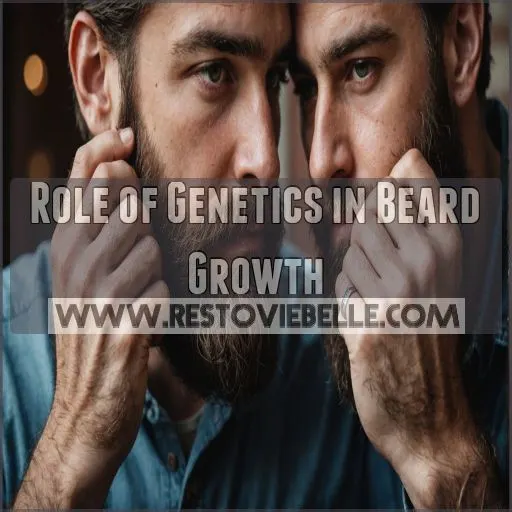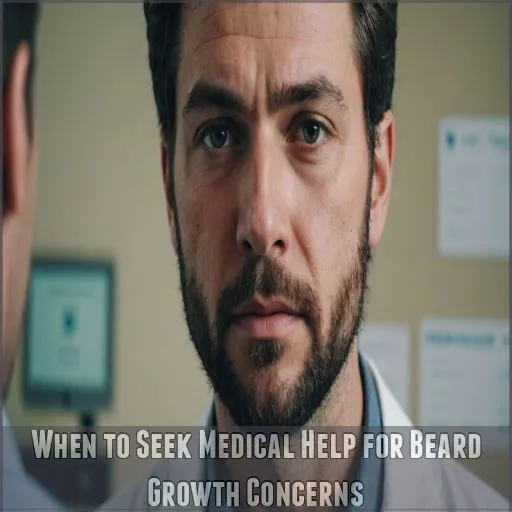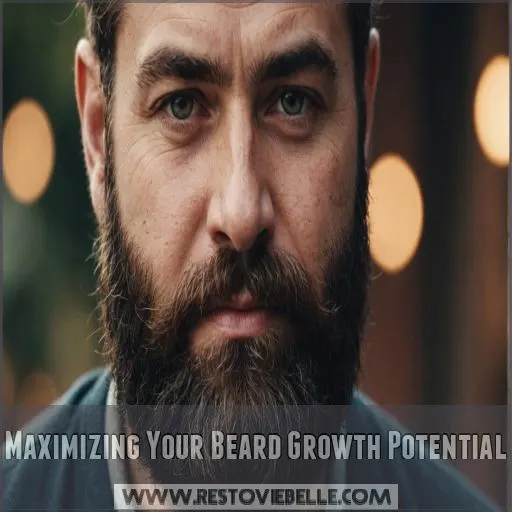This site is supported by our readers. We may earn a commission, at no cost to you, if you purchase through links.

Your beard potential is largely written in your genes, with factors like ethnicity and age playing supporting roles.
Hormones, particularly testosterone and its beefed-up cousin DHT, are the real MVPs of beard growth.
But don’t throw in the towel if you’re not sporting a lumberjack look just yet. Your beard might still be fashionably late to the party – many guys don’t hit peak growth until their 30s.
And while you can’t change your DNA, there are ways to give your facial hair a fighting chance.
Table Of Contents
- Key Takeaways
- Role of Genetics in Beard Growth
- Age and Ethnicity Factors
- Factors That Can Affect Beard Growth
- Can Everyone Grow a Beard?
- Nutrition and Lifestyle Tips for Beard Growth
- Debunking Common Beard Growth Myths
- When to Seek Medical Help for Beard Growth Concerns
- Maximizing Your Beard Growth Potential
- Frequently Asked Questions (FAQs)
- Is it possible to never get a beard?
- Can I grow a beard if my dad can’t?
- How do you know if you can grow a beard?
- Why can’t some guys grow beards?
- How does facial hair affect respirator effectiveness?
- Can beard hair filter airborne particles?
- Does stubble growth impact respirator protection?
- Are certain beard styles better for respirator sealing?
- How do anabolic steroids affect beard growth?
- Conclusion
Key Takeaways
- Your beard-growing potential is mostly determined by your DNA, so don’t beat yourself up if you can’t sprout a Viking-worthy mane. Genetics, ethnicity, and age all play a role in determining your facial fuzz fate.
- Hormones are the MVPs of beard growth, with testosterone and DHT leading the charge. If your beard is looking a bit sparse, your hormone levels might be calling the shots.
- Don’t throw in the towel if you’re not rocking a lumberjack look in your 20s. Many guys don’t reach their peak beard growth until their 30s, so patience is key on this hairy journey.
- While you can’t change your genes, you can give your beard a fighting chance. A balanced diet, stress management, and a healthy lifestyle can help you make the most of what nature gave you. Think of your face as a garden – nourish it right, and watch those whiskers grow!
Role of Genetics in Beard Growth
As you might guess, your ability to grow a beard is written in your DNA.
From dad’s scruffy chin to those pesky genes deciding if you sport a goatee or mustache, your genetic cocktail plays a surprising role in beard thickness and growth pattern.
How Genetics Affect Beard Thickness
Ever wondered why your beard can resemble a sparse forest while your friend’s is a dense jungle?
Blame genetics! Your family’s beard patterns, influenced by beard genetics, determine follicle sensitivity to hormones like DHT, affecting beard growth and thickness.
Even alopecia barbae plays a role, leaving you with patchy growth .
Embrace the uniqueness; it’s your genetic legacy!
The Impact of Androgens on Facial Hair
Androgens like testosterone are the masterminds behind beard growth stages.
They coax your facial hair follicles to sprout whiskers, with testosterone variations dictating the speed and density of your beard growth.
High androgen levels can make your beard lush, while lower levels might leave some patchiness.
So, if you’re dreaming of a mighty beard, nurture those androgen levels! .
How 5-Alpha Reductase Converts Testosterone to DHT
When you’ve wondered why some folks have lush beards, it often comes down to 5-alpha reductase.
This nifty enzyme, like a backstage magician, converts testosterone to DHT: the secret sauce behind androgen metabolism.
Keep that beard oil handy, but remember, not everyone can bypass beard growth myths with hair regrowth products, especially those suffering from alopecia barbae
.
It’s a genetic roll of the dice.
The Role of DHT in Stimulating Hair Growth
Imagine DHT as the secret sauce in your beard-growing journey. While 5-alpha reductase turns testosterone into DHT, this potent androgen binds to receptors, sparking beard growth and influencing your beard’s texture and thickness.
Beware of DHT inhibitors—though they tackle hair loss, they might slow your beard ambitions!
So, embrace that growth pattern and grab your beard balm, it’s beard season!
How Family History Influences Beard Growth
Your family history plays a quirky role in beard growth. You’ve got a mix of genes from both parents affecting your beard’s fate.
- Paternal Beard: Dad’s genes can shape your chin forest.
- Maternal Beard: Mom’s side might surprise you with beard genes.
- Genetic Inheritance: Other conditions like Becker’s nevus can also influence the growth .
Age and Ethnicity Factors
Beard growth can be as unpredictable as a teenager’s mood swing, influenced largely by your age and ethnicity.
Whether you’re waiting for those whiskers to finally connect or wondering if luxurious facial hair is in your future, understanding these factors will help set realistic expectations.
How Age Affects Facial Hair Coverage
Beard development takes its sweet time, often peaking in your mid-20s. By age 30, you’ll notice a fuller, more established look. Facial hair thickens with confidence but may begin thinning eventually.
| Age Range | Beard Stage |
|---|---|
| Teens | Sparse |
| 20s | Thickening |
| 30+ | Peak Growth |
Handle your beard journey with patience and humor!
The Age Range for Full Beard Growth
When does the magical beard growth timeline start ticking? Typically, puberty beard changes kick in, with full coverage developing between age 18-30.
But don’t sweat it if you’re a late bloomer, as factors affecting beard growth and individual variation mean everyone’s journey is unique, and your beard growth rate can be influenced by age, genetics, and health.
Genetics, in particular, play a major role in determining your beard growth potential. So, whether you’re sprouting a five o’clock shadow or still waiting, remember that patience is key, and you’re not alone in this hairy adventure!
How Ethnicity Influences Beard Thickness
Ethnicity plays a significant role in determining your beard thickness. Men of Mediterranean descent often have denser facial hair, while those of Asian heritage tend to have sparser growth.
Your genetic makeup and the sensitivity of hair follicles to androgens like DHT largely dictate the diameter and pattern of your beard.
Differences in Facial Hair Growth Among Ethnicities
Facial hair patterns can differ dramatically among ethnic groups, much like a pair of quirky twins with distinct quirks, especially in facial hair genetics
.
- Asian Men: Typically have lighter beards, often around the mouth .
- African Descent: Tend to have denser, coarser facial hair .
- Hispanics & Middle Easterners: Often sport higher facial mFG scores .
- Caucasians: Usually have moderate beard thickness.
Factors That Can Affect Beard Growth
If you’re wondering why your beard isn’t growing in as thick as you’d like, hormones could be to blame.
From low testosterone levels to medical conditions like alopecia areata, several factors might be affecting your facial hair journey.
Hormonal Imbalances and Their Impact on Beard Growth
Hormonal imbalances can throw a wrench in your beard-growing dreams.
Picture your hormones as a band; if testosterone’s the lead singer, thyroid issues or excess androgens might play backup, causing hair loss or patchiness instead of a full beard.
Keeping those hormones in tune can help turn that facial fuzz into a mighty mane.
The Effect of Low Testosterone Levels on Facial Hair
If you’re struggling with patchy or sparse facial hair, low testosterone levels may be to blame.
Testosterone plays a key role in stimulating beard growth, so addressing any hormonal imbalances could help you achieve the full, lush beard you desire.
Consider speaking with your doctor about testosterone replacement therapy or other hair-boosting treatments to get your beard growth back on track.
How Alopecia Areata Affects Beard Growth
Dealing with alopecia areata? It can feel like your beard’s playing hide and seek, thanks to those sneaky bald patches.
- Triggers: Stress and other unknown factors can kickstart this autoimmune condition .
- Impact: Your body’s immune system attacks hair follicles, causing beard hair loss.
- Treatment options: Consult a dermatologist to explore targeted therapies.
Remember, you’re not alone—many face this quirky beard mystery.
Other Medical Conditions That Can Affect Beard Growth
While alopecia areata, affectionately known as the beard’s arch-nemesis, wreaks havoc on facial hair, other medical conditions play spoilsport too.
Thyroid disorders, polycystic ovary syndrome, and certain medications can sneakily slow your beard’s roll.
| Condition | Impact on Beard Growth |
|---|---|
| Thyroid Disorders | Slows Growth |
| Polycystic Ovary Syndrome | Causes Sparse Growth |
| Medications | Can Cause Patchiness |
Stay vigilant, maintain your health, and keep that beard power strong!
Can Everyone Grow a Beard?
Can everyone grow a luscious, full beard?
The truth is, your beard growth potential is largely determined by your genetics.
While some may be blessed with a naturally thick mane, others may face challenges in cultivating their facial hair.
Factors That Determine Beard Growth Potential
Imagine your beard as a flourishing garden, where the soil’s richness is your genetics, and Hormonal Imbalances are unexpected weather.
Hair Follicle Sensitivity to DHT opens doors to the stages of growth, differing across Ethnicity Comparisons.
A balanced Lifestyle Impact—like exercise and sleep—perfects your grooming game. It’s all about nurturing what you’ve got with patience and care!
How to Assess Your Beard Growth Potential
Curious if you can grow a beard? Consider these four steps to assess your potential:
- Family History: Got bearded relatives? You might too! Genetics play a huge role .
- Hair Follicle Sensitivity: Check your face for early hair.
- DHT Levels: Exercising boosts growth!
- Ethnicity Comparison: Know your group’s typical beard traits .
Growing a beard’s like discovering hidden treasure!
Common Challenges in Growing a Beard
When you’re keen to grow a majestic beard, patchy areas can feel like a slap in the face.
Blame genetics, beard growth rate, or beard itching for these hurdles.
But don’t fret; a solid beard care routine—with nourishing oils and balms—can work wonders on beard texture.
Embrace the journey, and remember, every beard tells a unique story.
Managing Expectations for Beard Growth
Growing a beard isn’t just about willing it; it’s a journey. Here’s how to tackle it:
- Embrace Patience: Like waiting for water to boil, beard growth takes time.
- Consider Genetics and Ethnicity: These play big roles. Some inherit full beards, others don’t .
- Fine-Tune Diet and Manage Stress: Keep yourself healthy inside and out (Source).
Nutrition and Lifestyle Tips for Beard Growth
While genetics play a big role in beard growth, your diet and lifestyle can help you make the most of what you’ve got.
Let’s explore some practical tips to nourish your facial hair from the inside out and create an environment where your beard can thrive.
The Importance of a Balanced Diet for Beard Growth
You’ve got the genetics, but what’s on your plate matters too. A balanced diet isn’t just for your waistline—it’s your beard’s best friend.
Think of your facial hair as a garden; you need the right soil to grow those luscious locks. Let’s break down how your meals can make or break your beard game:
| Food Group | Beard Benefits | Examples |
|---|---|---|
| Proteins | Hair building blocks | Chicken, salmon |
| Healthy Fats | Testosterone boost | Avocados, nuts |
| Leafy Greens | Skin repair | Spinach, kale |
| Fruits | Hydration | Watermelon |
| Whole Grains | Overall health | Brown rice, quinoa |
Key Nutrients for Healthy Beard Growth
Your beard’s growth isn’t just about genetics – it’s also fueled by what’s on your plate. A balanced diet packed with key nutrients can give your facial hair the boost it needs.
Think of these nutrients as the secret ingredients in your beard-growing recipe:
- Biotin for hair strength
- Vitamin D for follicle stimulation
- Zinc to support testosterone production
- Protein for hair structure
- Iron for oxygen delivery to follicles
By nourishing your body, you’re directly helping your beard grow. So, let’s turn that stubble into a show-stopper!
Managing Stress for Better Beard Growth
Stress can put the brakes on your beard’s growth journey. Ever notice how your facial hair seems to slow down when life gets hectic?
That’s no coincidence. Chronic stress messes with your hormone levels, including testosterone – the fuel for your follicles.
To keep your beard game strong, try incorporating stress-busting activities into your routine. Deep breathing, or even a relaxing hobby can work wonders for your whiskers and your wellbeing. Meditation can also be beneficial in reducing stress for your wellbeing.
The Impact of Smoking on Beard Growth
If you’re dreaming of a full, healthy beard, smoking might be getting in the way. Lighting up doesn’t just harm your lungs; it can also impact your facial hair.
Nicotine and other toxins in cigarettes can restrict blood flow to your hair follicles, potentially stunting beard growth and quality.
Additionally, a diet lacking in protein and healthy fats can also hinder beard growth, as these nutrients support hair follicle health, and research has shown that genetic beard growth potential plays a significant role in beard thickness and growth rate.
If you’re serious about sporting a lush, healthy beard, consider kicking the habit and focusing on a balanced diet. Your future self (and beard) will thank you.
Debunking Common Beard Growth Myths
Beard growth myths can be as stubborn as a patchy beard, often caused by hormonal imbalances
. Let’s trim away the misconceptions and get to the root of the matter.
Despite popular belief, shaving doesn’t make your beard grow thicker or faster . It’s simply an optical illusion – when you shave, you’re left with blunt hair tips that might appear darker or coarser.
Your beard’s growth is primarily determined by genetics and hormones, not your grooming habits.
Another myth to bust: facial hair genes don’t come solely from your mother’s side. Both parents contribute to your beard potential.
And if you’re worried about cleanliness, fear not! A well-maintained beard isn’t dirtier than a clean-shaven face . With proper care and grooming, your beard can be just as hygienic as any other part of your body.
When to Seek Medical Help for Beard Growth Concerns
While genetics play a big role in beard growth, sometimes medical issues can throw a wrench in your facial hair plans.
If you’re concerned about patchy growth or sudden changes in your beard, it might be time to chat with a doctor – they can help you get to the root of any potential problems like alopecia barbae
.
Identifying Underlying Medical Conditions Affecting Beard Growth
Three key medical conditions can throw a wrench in your beard-growing dreams.
Alopecia areata, the sneaky hair thief, can cause patchy loss in your facial fuzz .
Hormonal imbalances, like low testosterone, might leave you with a sparse forest.
And don’t forget about thyroid issues – they can be real beard buzzkills.
If you’re struggling to grow that manly mane, it’s time to play detective and uncover any underlying culprits.
Consulting a Dermatologist for Personalized Advice
If you’re scratching your head over beard woes, it’s time to call in the big guns. A dermatologist can be your secret weapon in the battle for facial hair supremacy.
They’ll assess your unique situation, considering factors like genetics, hormones, and skin conditions . Don’t be shy – these docs have seen it all.
They might recommend treatments like minoxidil or even beard transplants for those struggling with patchy growth (Source).
Addressing Nutritional Deficiencies for Better Beard Growth
A surprising number of nutritional deficiencies can put the brakes on your beard-growing journey.
Iron, zinc, and biotin are essential beard nutrients that might be missing from your diet.
If you’re struggling with patchy growth, it’s worth checking in with your doctor. They can run tests to identify any deficiencies and recommend targeted supplements or dietary changes to fuel your facial hair ambitions.
Managing Skin Conditions That Affect Beard Growth
Itchy, flaky skin under your beard can turn your rugged look into a scratchy nightmare. Don’t let skin conditions sabotage your facial hair goals.
- Wash your face and beard twice daily with gentle cleanser
- Moisturize to prevent dryness and itching
- Use medicated creams for stubborn rashes or eczema
- See a dermatologist if you notice patchy hair loss (possible alopecia areata)
Remember, a healthy beard starts with healthy skin!
Maximizing Your Beard Growth Potential
Want to make the most of your beard-growing potential?
You’re about to discover how to create a personalized plan, set realistic goals, and maintain the right habits for great facial hair growth.
All while learning the importance of patience in your beard journey.
Creating a Personalized Plan for Beard Growth
Now that you’re armed with knowledge about your beard growth potential, it’s time to craft your personalized plan.
Start by checking out your current situation and goals. Are you aiming for a full beard or a stylish stubble?
Your plan should include a nourishing diet rich in beard-boosting nutrients (Source), and regular exercise to boost testosterone .
Don’t forget to factor in stress management and quality sleep for good growth.
Setting Realistic Expectations for Beard Growth
Regarding beard growth, reality often differs from expectations.
Your genetic blueprint plays a starring role in this follicular drama.
While some men sprout full beards at 18, others might be waiting well into their 20s for a respectable stubble.
Don’t let patchy growth discourage you – remember, Rome wasn’t built in a day, and neither is a majestic beard.
Patience is your bearded ally.
Maintaining a Healthy Lifestyle for Optimal Beard Growth
Your beard is like a garden, and your lifestyle is the soil it grows in.
To cultivate a lush facial forest, nourish it with these healthy habits:
- Feast on lean proteins and zinc-rich foods
- Sweat it out with regular exercise to boost blood flow
- Catch those Z’s for good testosterone production
- Zen out and manage stress to prevent hair loss
Remember, your beard’s potential is in your hands. Treat your body right, and watch your whiskers thrive!
Patience and Consistency in Achieving Your Beard Growth Goals
Growing a beard isn’t a sprint—it’s a marathon. Buckle up for a 2-6 month journey . To keep your spirits high, track your progress:
| Week | Milestone | Action |
|---|---|---|
| 2 | Stubble | Resist trimming |
| 4 | Patchy | Stay the course |
| 8 | Full | Shape if desired |
Remember, setbacks happen. Some days you’ll feel like a lumberjack, others like a patchy teen. Stick to your routine, nourish your body, and watch that facial forest flourish!
Frequently Asked Questions (FAQs)
Is it possible to never get a beard?
Believe it or not, some folks hit the genetic jackpot and never sprout a single whisker!
It’s possible to remain baby-faced forever due to genetics, ethnicity, or health conditions like alopecia areata.
Don’t fret though – you’re in good company!
Can I grow a beard if my dad can’t?
Beard genetics aren’t solely inherited from your dad . You might’ve snagged those facial hair genes from your mom’s side of the family.
So don’t let your old man’s smooth face discourage your bearded dreams!
How do you know if you can grow a beard?
Like a tree revealing its rings, your beard potential unfolds over time.
You’ll know if you can grow a beard by checking your genetics, age, ethnicity, and lifestyle habits.
Watch for hair growth patterns as you mature.
Why can’t some guys grow beards?
You can’t grow a beard? Don’t sweat it!
Your genes are the main culprit .
Hormone levels, especially testosterone, play a role too.
Some guys just hit the facial hair jackpot, while others rock the smooth look naturally.
How does facial hair affect respirator effectiveness?
Bristly beards beware! Facial hair hinders respirator effectiveness by interfering with the tight seal needed for protection.
You’re compromising safety when sporting stubble.
Consider a beard band or trimming to make sure your respirator fits snugly, safeguarding your health .
Can beard hair filter airborne particles?
Beards can act as a crude filter, but they’re not nearly as effective as proper respirators.
While facial hair may trap some particles, it’s not dense enough to make a big difference in filtering airborne contaminants.
Regular cleaning is important to prevent trapped allergens from entering your airways .
Does stubble growth impact respirator protection?
Ah, the age-old quest for rugged charm.
Stubble growth can really impact respirator protection .
Even a day or two of growth can reduce effectiveness by 20 to 1000 times compared to clean-shaven faces .
Time to rethink that scruff!
Are certain beard styles better for respirator sealing?
You’re out of luck if you’re hoping for a beard-friendly respirator style.
Research shows that any facial hair at the seal can reduce protection by 20 to 1000 times compared to clean-shaven faces.
Safety first!
How do anabolic steroids affect beard growth?
John’s patchy beard transformed into a full mane after steroid use.
Anabolic steroids can boost beard growth by increasing testosterone levels, which may lead to thicker, faster-growing facial hair.
However, they come with serious health risks .
Conclusion
Growing a beard is like nurturing a garden – it takes patience, care, and the right conditions. While not everyone can grow a beard, understanding the factors at play can help you maximize your potential.
Genetics, age, and ethnicity play major roles, but don’t despair if you’re not sporting a lumberjack look just yet.
Focus on maintaining a healthy lifestyle, proper nutrition, and skincare routine. Remember, your beard journey is unique.
Embrace what you can grow, and rock your facial hair with confidence, no matter its fullness.













